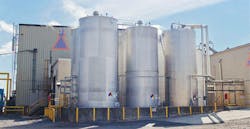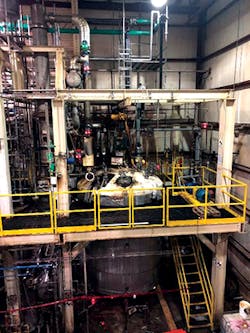In this article:
- Batch control and advanced multi-step processes
- New equipment and upgrades
- Safety systems and recipe sets
- Establishment phase and maintenance schedules
In 2020, MFG Chemical embarked on a major three-plant upgrade of its manufacturing facilities in Dalton, Georgia. The custom chemical manufacturer had already completed a smaller upgrade in 2018, after purchasing a new location in Pasadena, Texas, adding to MFG’s capacity with two new reactors.
The latest upgrades at the Dalton plants began with a focus on safety, and the more the facilities looked into what automation could do for the business, the more it implemented the technology across the board. The upgrades were also driven by a need for increased capacity and infrastructure to support a growing market. “MFG Chemical is undergoing tremendous growth in volume along with the addition of many new product lines,” says Dr. George Graham, vice president of operations. Instead of a programmable logic controller (PLC) or relay logic system, the manufacturer went with a full distributed control system (DCS). “PLCs do not have the same scalability and flexibility as a full distributed control system,” Graham says. “A DCS was the right choice for us to facilitate the rapid change our operation is experiencing.”
In addition to new process control technology, improvements at the plant included new cooling towers, upgraded reactor piping for improved pressure relief, and new safety instrumentation systems. All three plants upgraded control systems, cooling systems, and relief systems, and the new technology supports the manufacturer’s strength in advanced chemical processes (see Figure 1).
Batch control and advanced multi-step processes
MFG Chemical is experiencing increased demand from specialty chemical markets, such as fuel and oil additives, agriculture, asphalt, paint and coatings, graphic arts, lubricants, mining, personal care, soap and detergents, pulp and paper, and water treatment (see Figure 2). Because it manufacturers a wide variety of products, safety was forefront for the upgrades, and with a DCS, new safety functions, as well as new I/O and complex control functions can be easily added. “An additional advantage for chemical operations where I/O is not concentrated in one location but distributed throughout the facility is the ease of adding remote I/O panels to the DCS,” says Graham.
Deciding exactly what equipment to automate, what was most important and what added the most value to MFG Chemical’s processes and its customer’s final products, Graham says it took significant analysis of the products it manufacturers. “It was really very interesting as we studied all of the different products that we make. It sounds simple to say that, but across our portfolio, that turned into a very complex analysis, where eventually we developed a system of recipe sets and batch control procedures to automate those processes,” Graham says. The project goals were simple: improved safety, increased capacity, and enhanced efficiency. But it was really the automation, specifically controlling continuous feeds to the reactors, which is key toward opening the door to manufacturing more advanced chemistries.
“Automatic feed control of multiple simultaneous feeds is one of MFG’s distinctives,” says Graham. “Integrating these control functions into a DCS has further expanded our capabilities in this area. This is one of the most complex processes to automate, which required significant engineering and programming.”
Other control features that simplified the process for operators included automated temperature controls for the reactor. “Having both exothermic and endothermic reactions, automatic control of heating and cooling has enabled a greater precision of control and reducing the need for operators to continuously monitor temperatures and change setpoints for different phases of the reaction,” Graham says.
“The biggest upgrade done overall was valve automation,” Graham says. “Valve automation reduces the physical stress on the team members and enables valves to be actuated while watching other processes on the DCS.” The upgrades included a large number of actuated valves and/or manual valves with limit switch feedback to the DCS. Some of the valves are fully automated with limit switches that feed back to the DCS to identify as open or closed. “A lot of other valves, however, are manually actuated but they have limit switches on them to feedback position to the DCS,” Graham says.
New equipment and upgrades
No new processing equipment was added, but the existing reactors, distillation columns, condensers and receivers were outfitted with new automation hardware. “There was a litany of new flow metering devices,” Graham says. New mag meters measure cooling water flow rate directly from the cooling towers, ensuring the primary supply of cooling water. “We use vortex meters to measure cooling water flow rates for each reactor and condenser, ensuring sufficient cooling is always available,” says Graham. By measuring the temperature of its cooling water discharge, MFG is tracking how much energy is being dissipated from the reactor. Many new temperature and pressure indicators were also installed. “Nothing revolutionary there, but a lot of new I/O points that were installed,” he says.
Additional cooling towers are part of the improved cooling capacity, which has improved cycle times on cooling-intensive processes. “We roughly doubled the cooling water flow to each reactor. With reactor-based chemistry, especially feed rate-controlled reactor-based chemistry, one of the big limitations is always dealing with exotherm. And so improving our cooling capacity will enable us, eventually, to increase our feed rates because we’re better able to dissipate the exotherm,” says Joe Dymecki, vice president of sales at MFG Chemical.
Automation will also improve the process of heating, before flipping over to the cooling phase. “Before those were all operator manual interventions,” Dymecki says. “Now, operators can add a button, put a reactor going from heating to cooling, and it’ll automatically depressure the jacket, lower the jacket down, and flood the jacket with cooling water. Those were all somewhat manual tasks before we had an automated system,” he added.
The new cooling water system substantially increased the flow rates to the reactors and condensers. “This increases the heat transfer so more heat can be removed from the reactor every minute,” says Graham. Flow rates were designed within proper engineering limits, so maintenance should be minimal, he added.
Additional quench tanks were also installed on the relief system. “The quench tanks contain a prescribed amount of water/ethylene glycol solution,” says Graham. The level and glycol concentration will be checked on an annual frequency.
Safety systems and recipe sets
Safety was essentially where the project started, and it’s paramount to the company’s success with such a wide variety of products and chemistries. “We looked at the variety of chemistries that we make. We looked at the opportunities for mistakes that could be made and what the outcomes could be. And so this was one way that we really designed a relief system that encompasses the boundaries of what could happen from a process hazard perspective,” Graham says. In addition to new quench tanks, all new relief piping was installed (see Figure 3). “That system is really prepared for the contingencies that we could introduce to it because we do run a lot of quite reactive chemistries,” Graham says.
On the reactors, the system has continuous monitoring of reactor pressure, temperature, and cooling functions. “All of that goes into a complex reactor interlocking scheme,” explains Graham. “We measure both absolute value and rate of change, so if the rate of change is too high on any of those parameters, then that will interlock the reactor as well and throw it into what we call max cool.” The max cool function will interrupt all feeds to put the reactor into a safe condition, he adds.
While that sounds somewhat straightforward, Graham says that the large number of products made there makes that a more complicated to automate. The recipe sets, put into different chemistry groups, help organize different high and low limits for each group. “That took a lot of work. We had a lot of engineers, both from a process engineering perspective and mechanical engineering and safety, to come up with that,” Graham says. “And that’s a process that’s never finished. We do that every time we introduce a new chemistry.”
MFG Chemical uses a management of change process for each new product introduction, updating recipe sets and batch control procedures are required prior to final implementation. The company performs a process hazard analysis (PHA), a requirement of the OSHA process safety management for hazardous materials, and which helps determine what administrative and engineering controls are required to address certain risks involved in chemical manufacturing. PHAs are required on all end products and process equipment.
In a typical week, a single reactor might produce one product or some weeks that number grows to three or more. “The market is very dynamic right now,” Graham says. And multi-reactor, multi-step processes are MFG’s specialty (see Figure 4). “It’s very common for us to make a base in one reactor, and then use that as a feed for another reactor. We recently developed one that’s a three-step reaction, followed by two distillation steps,” Graham says.
To accommodate the interlocking feed controls, the project re-engineered the sampling systems. With such a large variety of chemistries, Graham said it didn’t make sense to include online analytics. Operators still manually take samples, which are sent to the lab for analysis. More spring-loaded sampling ports were installed to ensure that no port was ever used as a feed port, thereby bypassing safety interlocks, Graham says.
For all three plant upgrades, MFG Chemical worked with systems integrator Premier Systems, which specializes in Yokagawa DCS systems. On-site installation spanned from the summer of 2020 to April 2021, but years of planning prior to that made the process smooth, even during a global pandemic. Overall, the project only lost about two weeks due to COVID-19. “I would say MFG artfully navigated the whole process to avoid schedule impacts,” Graham says. Like everyone, the project managed with new safety protocols, but the two-year front-end design phase kept the project wholly on track. On a few occasions during the pandemic, the project felt a crunch when certain staff were affected. “The highly specialized functions were the hardest to replace,” Graham says.
Establishment phase and maintenance schedules
Now, the automation system frees operators to focus on more production-critical work, and maintenance operations for some equipment has shifted significantly. The new hardware requires different care and new calibration programs.
“You have a lot of new equipment to take care of, and your team has to learn how to operate that equipment, care for it and calibrate it,” Graham says. “But on the backside of it, we have a lot of new tools.”
The health of the field instruments is tracked and collected. “The instruments will tell you when there’s something wrong with them,” Graham says. “We’ve also built that into our interlocking routines. If you have safety critical instrumentation that requires attention, then it will prevent the sequence from moving forward.” His expectations are that OEE will be significantly improved in the long run.
About three months after commissioning the new equipment, the team is still in what Graham calls the establishment phase. “The reactive maintenance team is having to deal with all this new hardware that’s been installed in the plant,” Graham says. At the same time, the engineering team is working on the spare parts lists and the establishment of critical spares. “What are the parts that we’re going to be able to easily obtain off the shelf versus the parts that will have long lead times that we need to keep critical spares for,” Graham says. “There’s never enough money to buy everything you might need.” Spare parts decisions are made by considering return on investment and risk factors, he added.
The final piece of the establishment phase is the annual calibration and PM schedule for safety equipment. “With safety relevant hardware you will at least initially check that hardware once a year at a minimum, maybe more frequently if you have a device that proves itself to have a higher failure rate,” Graham says. “But at least once a year until you can establish reliability information on that hardware, then you would have the opportunity to extend checks on that.”
While the data historian on the DCS, which stores all data for future use, has been used to evaluate small installation failures, it will be most useful after this establishment phase as the plant moves toward predictive maintenance and improved asset care.
“I’ve done a number of these implementations over my career,” Graham says. “The features of the modern DCS systems, their ability to communicate with smart sensors and smart hardware in the field, it’s light years ahead of where we used to be, and so now there’s a lot of diagnostics built into the systems. The systems are so flexible in terms of growth and the ability to add I/O onto the systems. That’s a huge evolution over the course of my career.”
This story originally appeared in the August 2021 issue of Plant Services. Subscribe to Plant Services here.






